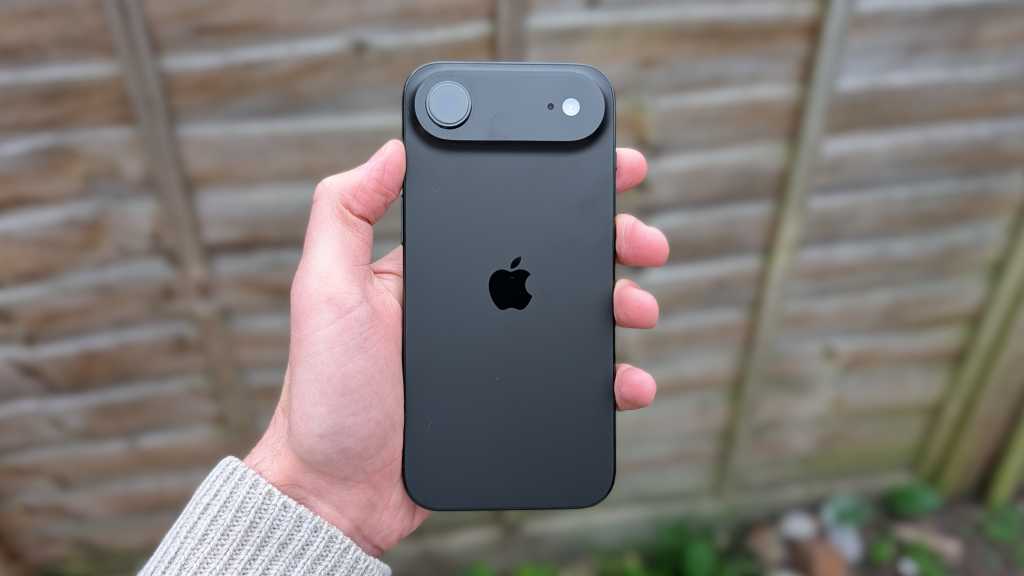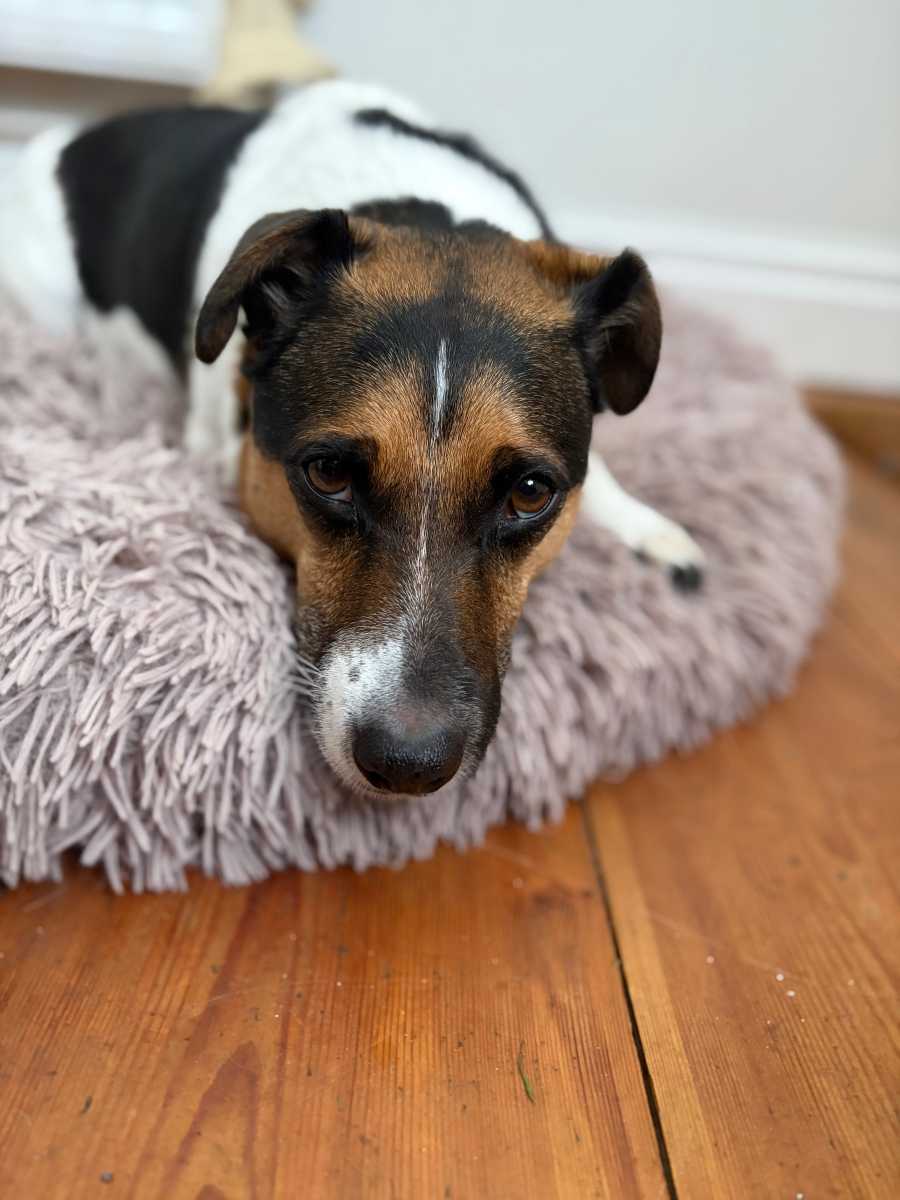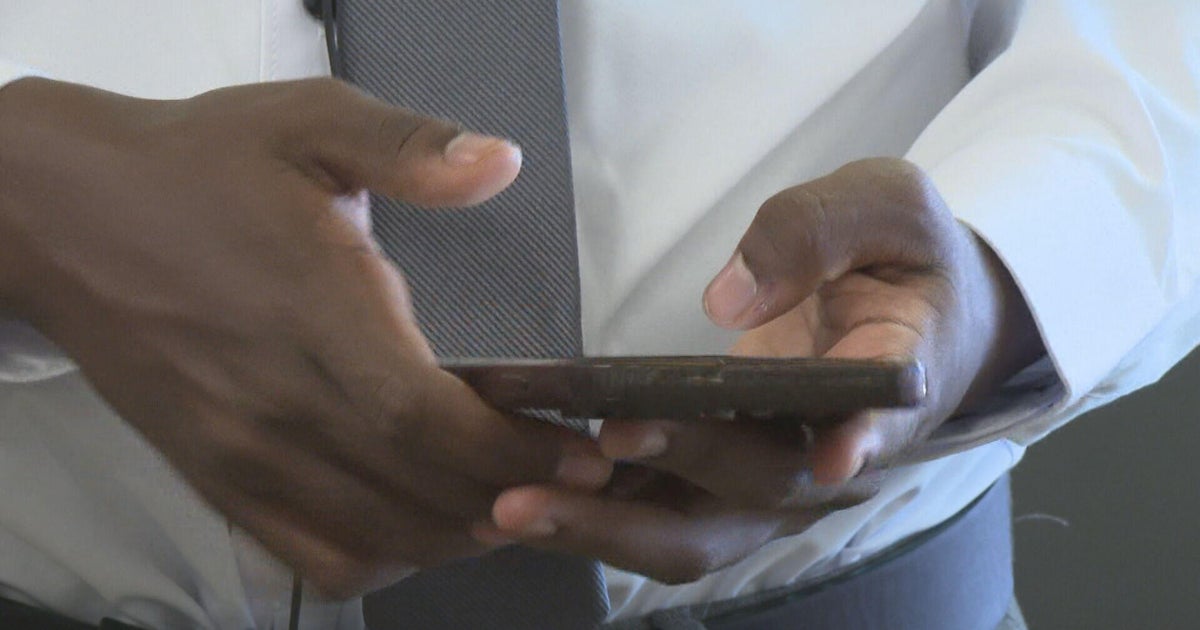At a glance
Expert’s Rating
Pros
- Gorgeous yet durable design
- Stunning display
- Stellar performance
- Strong main camera
Cons
- Terrible zoom photography
- Poor speakers
- Slow charging
- Too expensive for what it is
Our Verdict
I’ve enjoyed using the iPhone Air more than I expected to, but there are too many downsides to recommend it to most people. Unless you love the ultra-slim design, the regular iPhone 17 is a much better buy.
Price When Reviewed
This value will show the geolocated pricing text for product undefined
Best Pricing Today
Best Prices Today: Apple iPhone Air (2025)
The iPhone Air is the biggest thing to happen to Apple’s smartphones since the iPhone X made its debut eight years ago.
It’s a reimagining of what an iPhone can look like, ditching the tried-and-tested design for something far more daring.
The ultra-slim chassis is an impressive feat of engineering, but it has some very real consequences elsewhere. Despite the £999/$999 price tag, the iPhone Air has significant downgrades compared to even the base iPhone 17.
Is it worth it in exchange for a potential slice of the future? I spent a week using the iPhone Air as my main phone to find out.
Design & Build
- Ultra-slim 5.6mm design
- Durable, titanium build
- IP68 water and dust resistance
The iPhone Air is a phone I never expected Apple to make.
Sure, there are slimline Air-branded versions of its iPad and MacBook, but a smartphone is a different kettle of fish. Not only is it limited by the height of a USB-C port, but it also requires lots of different components to be housed within a very small space.
But I’m grateful for Apple’s ambition, and from a design perspective, the iPhone Air has undoubtedly paid off.
The iPhone Air is a gorgeous device to hold, with a thickness of just 5.6mm (0.2mm thinner than Samsung’s Galaxy S25 Edge) and a weight of 165g giving it a barely-there feel in your hand. Alongside a tiny bezel around the edge of the screen, the immersive feel of using it is unmatched by any phone I’ve ever tried.
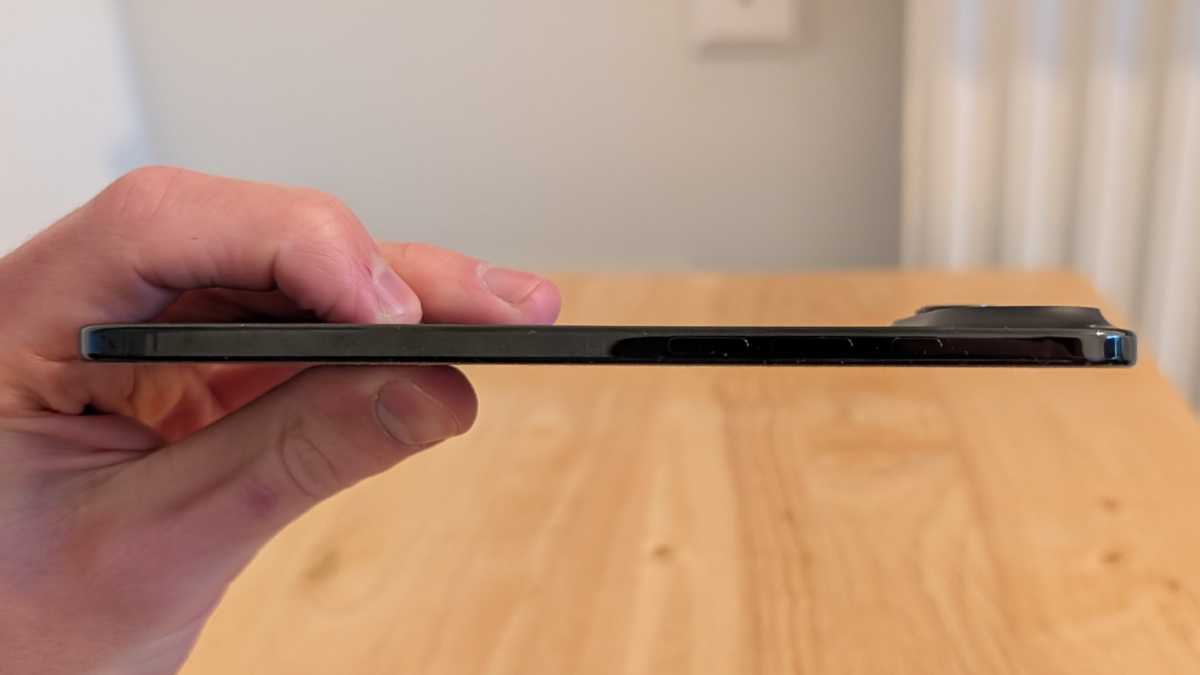
Anyron Copeman / Foundry
There are rumours that the iPhone Air’s design could be the blueprint for the upcoming foldable iPhone, which is slated to launch in 2026. If Apple stuck two of these together and got the hinge right, I’d be very happy indeed.
Even without a folding mechanism, one of my big concerns was durability. Judging by the photos, it almost looks like you could snap the iPhone Air in half if you tried hard enough.
Interestingly, Apple has shifted back to aluminium frames on the iPhone 17 range, but retained titanium here. I’m very glad it did – titanium is both lighter and stronger than aluminium, which makes it perfect for the Air.
And I needn’t have worried about durability. Apple’s engineers have clearly made this a top priority, because it doesn’t feel flimsy at all. I briefly tried bending it, and there was no flex, let alone any signs of damage. YouTuber JerryRigEverything’s testing was much more extreme, and it fared very well there, too.
From a design perspective, the iPhone Air has undoubtedly paid off
If it were any other phone, I’d suggest using a case. Apple’s official one, which it sent to me alongside the device, is about as slimline as it gets, but it undoubtedly detracts from the stunning design. I’d be tempted to risk it and go case-free.
Fortunately, grip isn’t an issue. I was able to use the iPhone Air without worrying about it falling out of my pocket or off a table, which is a common concern for glass-backed phones.
The matt coating on the rear also does a good job of resisting fingerprint smudges on the Space Black model I tested, although it’s also available in much more interesting Cloud White, Light Gold and Sky Blue variants, if you’d prefer.
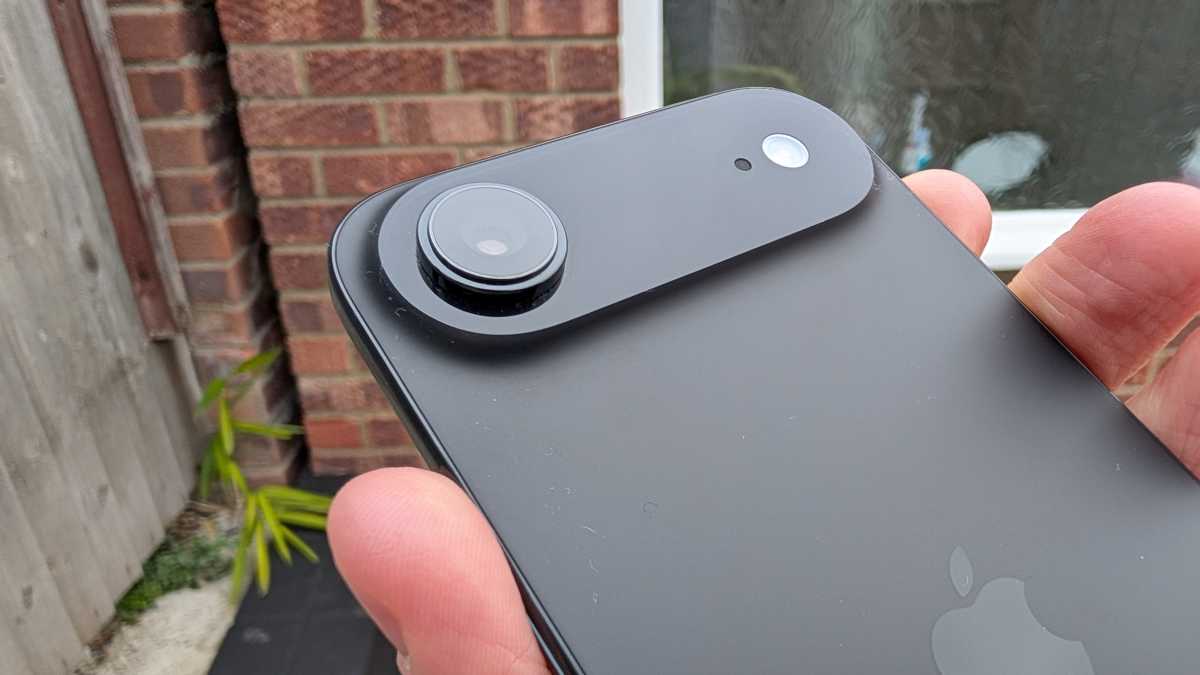
Anyron Copeman / Foundry
Like all the 2025 iPhones, the Air boasts an IP68 rating. Apple’s claims go beyond the usual for water resistance, stating that it can survive submersion in up to six metres of water for up to 30 minutes. It’s also fully dust-proof.
Elsewhere, the iPhone Air’s haptic feedback is some of the best in the business. I’m not usually a fan of vibrations while typing, charging and using physical buttons, but it really impressed me. The subtle jolt when enabling Silent mode via the Action Button is a personal favourite.
The latter is one of five physical buttons around the side of the device. Alongside power and volume controls, it’s also joined by the Camera Control button. I find it to be a useful shortcut to the camera app and a nice physical shutter button, but it’s slightly awkwardly placed and too fiddly to offer intuitive controls.
Screen & Speakers
- 6.5-inch OLED panel
- Adaptive 1-120Hz refresh rate
- Mono earpiece speaker
The iPhone Air’s display is my favourite thing about it. The combination of superb quality and that immersive design I mentioned earlier delivers a viewing experience that few handsets can match.
It’s a 6.5-inch panel that stretches almost all the way to the edges of the phone, with its 1260 x 2736 resolution meaning it matches all the iPhone 17 models for pixel density (460ppi).
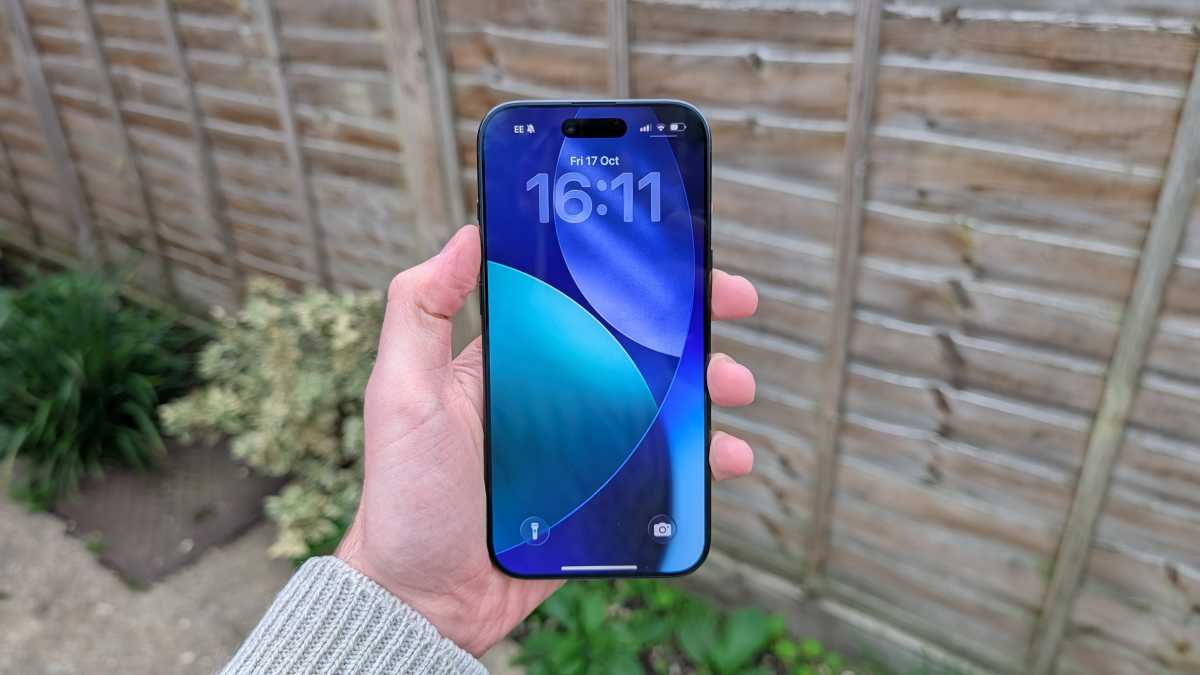
Anyron Copeman / Foundry
Apple has fully embraced OLED on its iPhone flagships in recent years, and I’m glad it has. The rich, vibrant colours and deep blacks are particularly apparent here, making it an ideal device for watching YouTube or TV shows. I wouldn’t usually recommend watching movies on a phone, but the quality of the visuals here won’t let you down.
Meanwhile, the 120Hz refresh rate works in tandem with LTPO technology, ensuring it can automatically drop as low as 1Hz to save battery life when not required. The latter is perfect for the Always-On display, which allows you to see essential information while the screen is off, though it’s something I prefer to keep switched off.
The iPhone Air is also excellent when it comes to visibility. An impressive peak brightness of 3000 nits makes it easy to use in basically any outdoor environment, with the Ceramic Shield 2 front cover including an effective anti-reflective coating. Indoors, the …. nits figure I recorded is among the highest on any phone.
I genuinely can’t think of anything the iPhone Air’s screen isn’t good at, which is rare for a phone display.
I genuinely can’t think of anything the iPhone Air’s screen isn’t good at, which is rare for a phone display
This will come as no surprise if you’re familiar with the iPhone, but there’s no fingerprint sensor of any description. Instead, the iPhone Air relies on the pill-shaped Dynamic Island cutout at the top of the screen, which houses the Face ID sensors.
Some Android phones, including the Pixel 10 series, offer a 3D face unlock that’s secure enough to be used to authenticate payments and log into banking apps. But for a seamless experience in practically any situation, I still prefer Face ID.
Unfortunately, space constraints mean the iPhone Air’s speakers have been compromised. With no speaker at the bottom, it’s totally reliant on the earpiece for audio, and quality suffers as a result.

Anyron Copeman / Foundry
Compared to most phone speakers, music sounds a bit washed out, with the sound lacking any bass or significant depth. While perfectly clear at lower volumes, making it well-suited to phone calls and podcasts, it can get distorted as you make it louder.
Specs & Performance
- Apple A19 Pro chipset
- Strong performance, including while gaming
- eSIM-only
The iPhone Air might be compromised in some areas, but performance isn’t one of them.
It’s equipped with the same A19 Pro chipset that’s found in the iPhone 17 Pro models. This 3nm chip is the most powerful that Apple has ever made, and comparable to Qualcomm’s Snapdragon 8 Elite Gen 5 on the Android side.
Alongside 12GB of RAM across all models, performance is absolutely superb. The iPhone Air is consistently fast and ultra-responsive, handling regular everyday use without breaking a sweat.
My typical day while testing included lots of web browsing, messaging and emails, plus some social media, map navigation and photography. None of this was a match for the iPhone Air’s power, even when using multiple apps simultaneously and quickly switching between them. It’s also one of the few phones I’ve tested where I’ve never experienced a single app crash or freeze of any description.
The iPhone Air is as good for gaming as basically any other iPhone or Android flagship, which is impressive
I was concerned that the phone’s slim design might affect more demanding workloads, but I needn’t have worried.
Unlike the Galaxy S25 Edge, which I tested earlier this year, the iPhone Air avoids any significant build-up of heat while playing demanding games such as Asphalt Legends, Genshin Impact and EA Sports FC. The back of the phone gets a little warm during longer sessions, but that’s about it.
And crucially, there’s no noticeable slowdown or dropped frames. The iPhone Air is as good for gaming as basically any other iPhone or Android flagship, which is impressive.
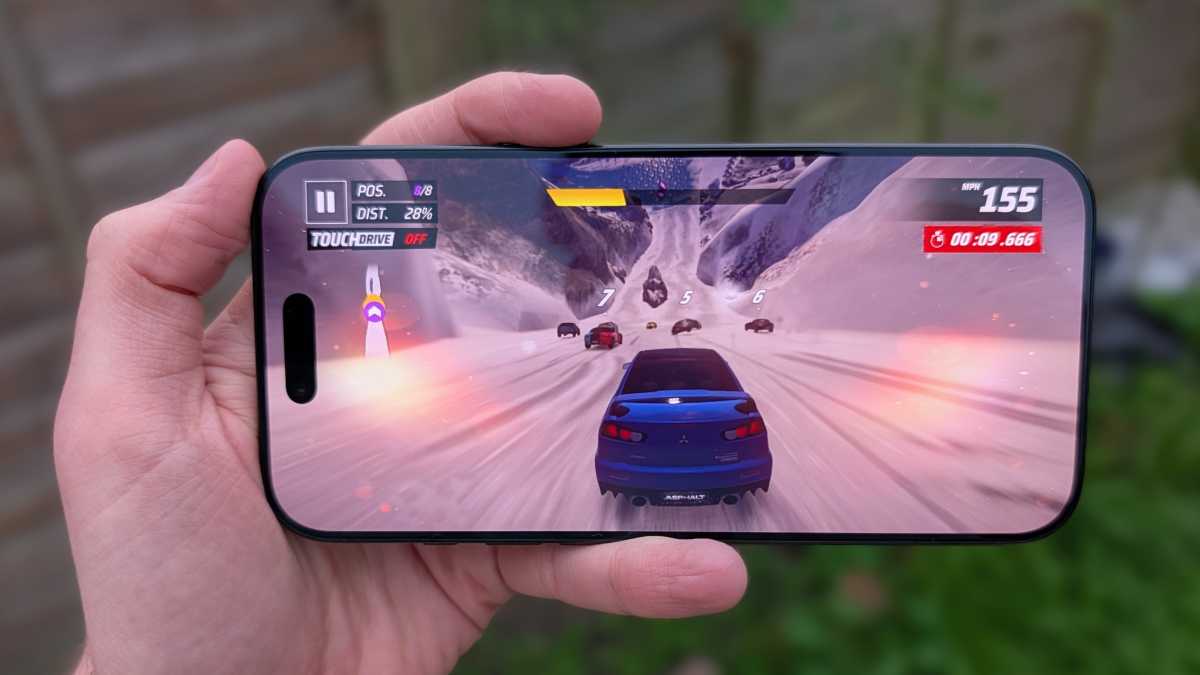
Anyron Copeman / Foundry
In terms of connectivity, it’s important to note that the iPhone has no physical SIM card slot, so you’ll have to use eSIM. While the iPhone has been eSIM-only in the US since 2022, this is the first time Apple has launched a model like this internationally.
That makes the process of switching to the iPhone Air and keeping your number much more complicated than just popping your SIM card in, although it’s still very much possible. If it’s a hassle you’d really rather do without, all other iPhone 17 models support physical SIM cards outside the US.
The iPhone has never supported expandable storage, so the removal of a SIM tray doesn’t affect that. If you think the entry-level 256GB won’t be enough, there are also options for 512GB and 1TB.
Apple iPhone Air benchmarks
Cameras
- Single 48Mp rear camera
- 18Mp selfie camera
- Centre Stage and Dual Capture features
The iPhone Air’s camera system is a real mixed bag, and it’s likely to be a dealbreaker for many people – myself included.
On one hand, the phone has the same 48Mp, f/1.6 main sensor as the regular iPhone 17, which itself is only a small downgrade from the 17 Pro and 17 Pro Max.
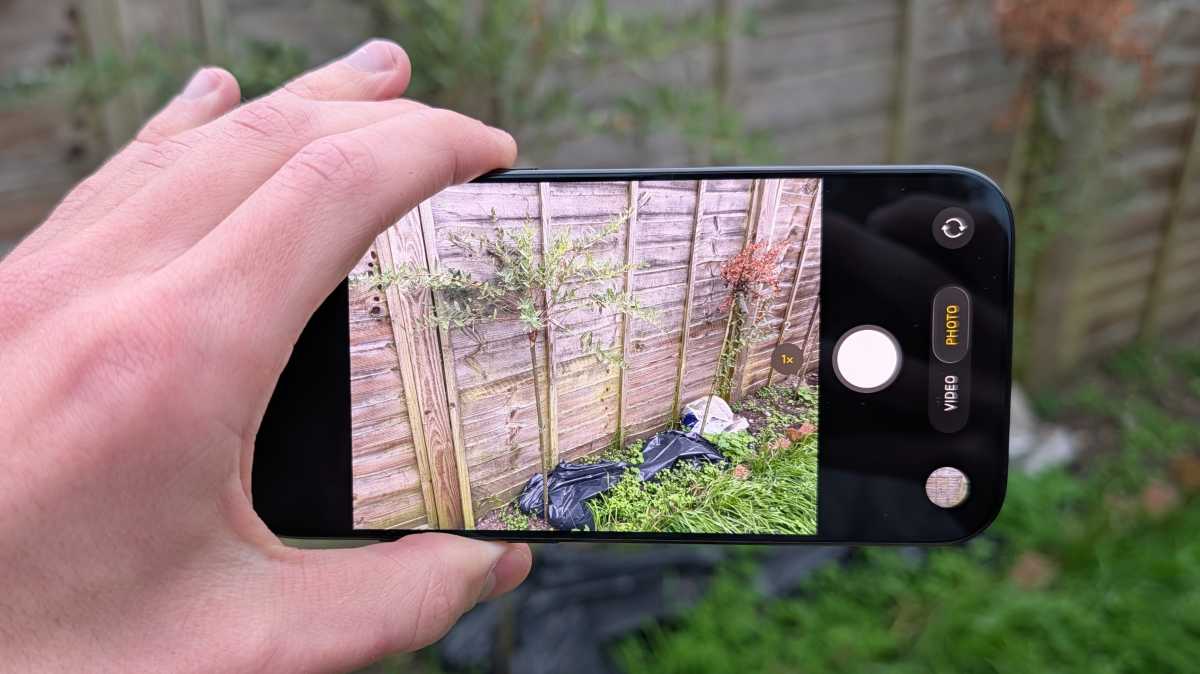
Anyron Copeman / Foundry
It’s a very good lens, delivering superb detail and impressively accurate colours. I really enjoy how true-to-life images from the iPhone Air are, even if they might require some editing later.
In good lighting conditions, dynamic range is excellent, while it handles shadows better than any phone I’ve tried. However, exposure can be an issue at times, with the phone sometimes compensating for a darker scene by blowing out the skies.
The iPhone Air also takes gorgeous portrait photos, combining crystal-clear subjects with a subtle bokeh effect that does a good job of edge detection. The result is an impressively professional-looking image, and you can easily adjust the level of background blur after the photo has been taken.
The main lens also performs well in low-light conditions. Night mode, which is automatically enabled by default, boosts brightness and removes noise, turning an average photo into a very good one.
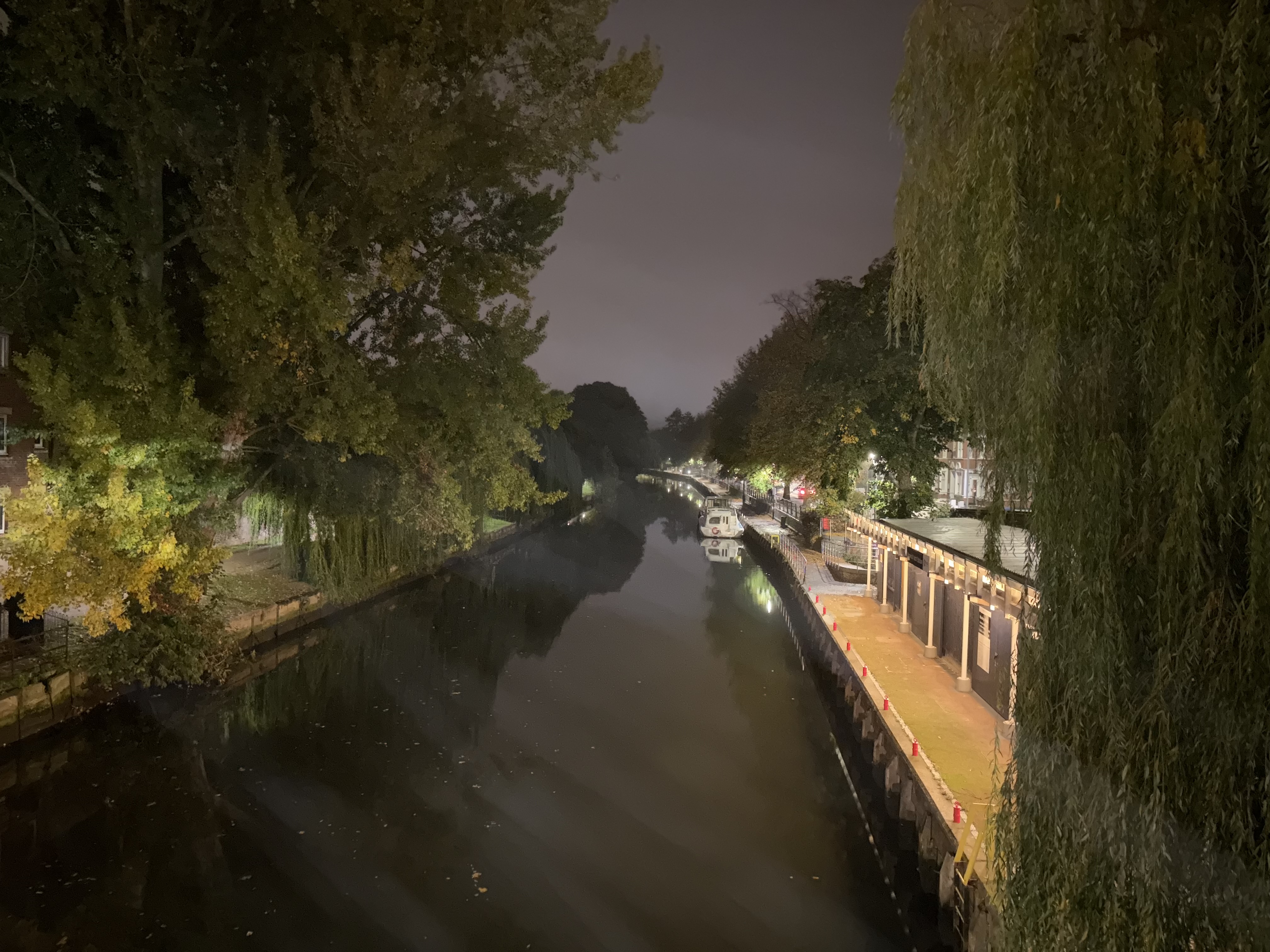
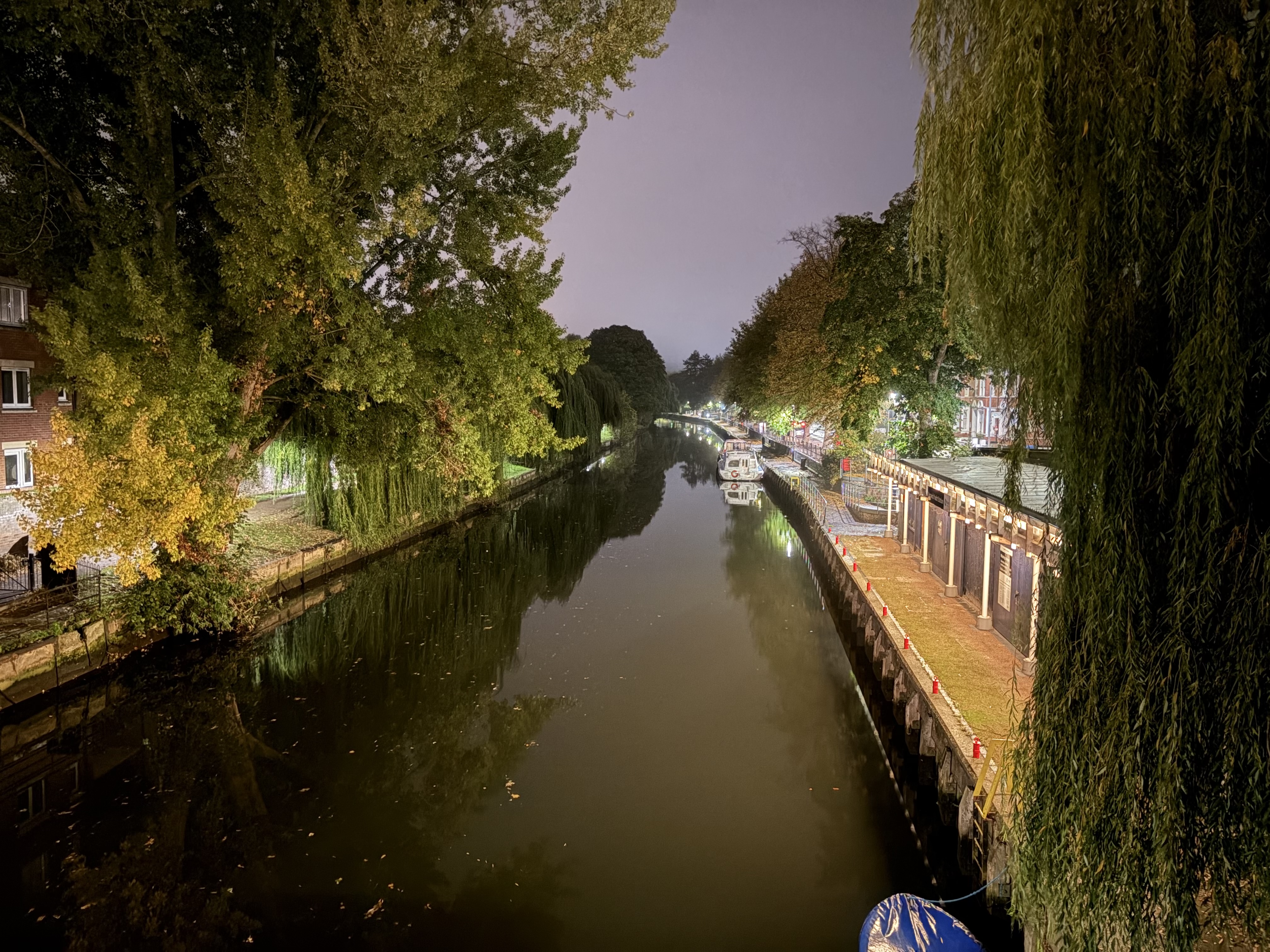
I’ve found the rear camera to be equally adept at taking photos of people, architecture and landscapes. I only wish it had support from other lenses on the back.
I don’t care how slim it is – to have only one lens on the back of a £999/$999 phone in 2025 is inexcusable. Inevitably, the camera system is much less versatile as a result.
Want to capture more in the frame? Rather than just tapping the 0.5x button to switch to the ultrawide, you’ll have to hope you can stand further back, which often isn’t possible.
And don’t let Apple’s claims of a 2x ‘optical zoom’ fool you. It simply crops in on the image from the main lens, sacrificing some key details in the process. Quality is on a rapid downward spiral beyond that, and it speaks volumes that you can’t go beyond 10x.
If you care about zoom photography, my message is clear: do not buy the iPhone Air.
However, the front-facing lens is another success story. The 18Mp, f/1.9 sensor is the same on the iPhone 17 models, and it might be the best selfie camera on any phone.
If you care about zoom photography, my message is clear: do not buy the iPhone Air
Why? It’s not just the fact that it takes great selfies in almost any environment, although the accurate skin tones and superb level of detail are very important.
The iPhone Air also features Apple’s Centre Stage tech, which takes a lot of the hassle out of getting a good selfie. It uses the combination of a square sensor and AI to automatically adjust the zoom and orientation to get everyone in frame. It’s not quite instantaneous, but it’s an easy way to significantly improve the quality of your selfies.
See more camera samples in the gallery below:
Elsewhere, iPhone Air follows in the footsteps of recent iPhones by delivering excellent video quality. Footage from both the front and rear lenses shows no noticeable decline in colour accuracy or detail, while OIS (optical image stabilisation) ensures everything remains impressively smooth.
You can capture from both lenses simultaneously via the Dual Capture feature, though this feels best suited to content creators or anyone who regularly uploads to social media.
Software & AI
- iOS 26 out of the box
- Long and prompt software updates
The iPhone Air runs iOS 26 out of the box, meaning you get access to the new Liquid Glass aesthetic.
It’s a clear shift in the way Apple wants its UI to look and feel, with various elements that fade into the background but then respond expressively when you interact with them. The company claims it even behaves as glass would in the real world, but that feels like a bit of a stretch.
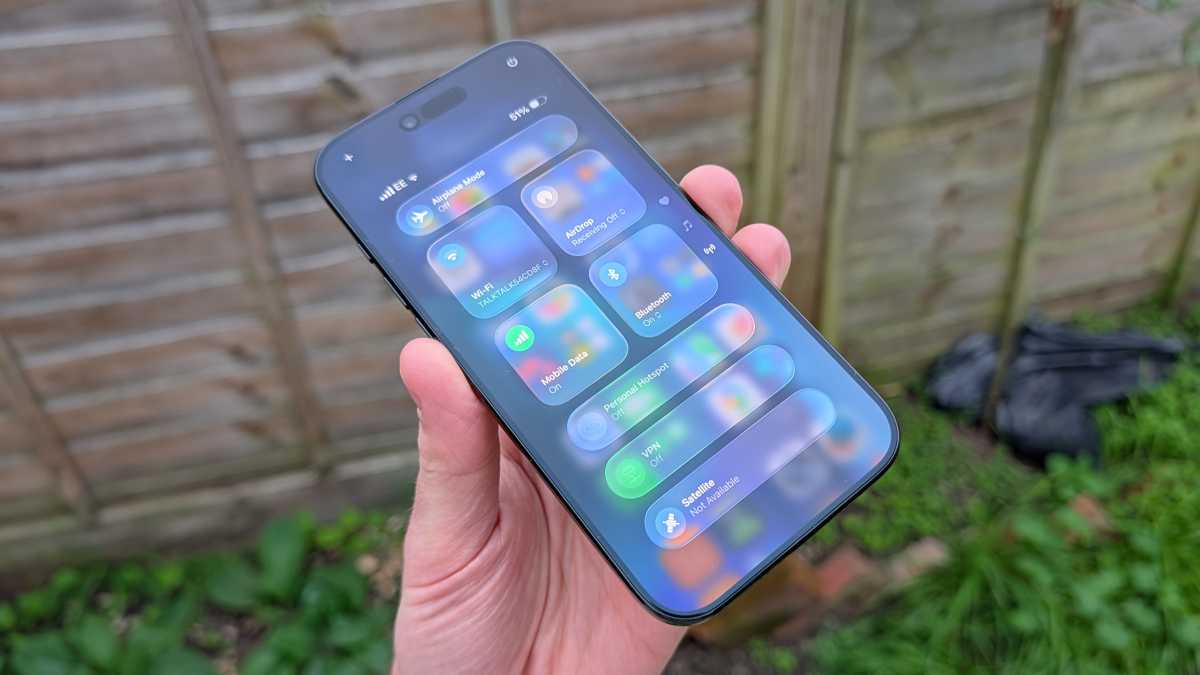
Anyron Copeman / Foundry
Overall, I’ve enjoyed my interactions with Liquid Glass. It’s a subtle shift, but one that helps the iPhone Air feel less like an inanimate piece of technology and more part of the natural world (even though it isn’t, of course).
The effect is magnified when you find a third-party app that’s embraced Liquid Glass, though this can border on annoying when once-familiar menus look almost unrecognisable. I like Liquid Glass on stock apps, but that’s enough.
Elsewhere, iOS 26 continues to embrace customisation, allowing you to control everything from the app icons and widgets to system-wide themes and even lock screen photos that come to life.
If you don’t really care about AI, iOS 26 is an accomplished and intuitive operating system
The version of iOS you see today is almost unrecognisable compared to a decade ago, and all the better for it. As someone who uses Android most of the time, I thought I’d struggle a lot more than I have, though there is a clear adjustment period.
One area in which the iPhone still struggles is AI. The Apple Intelligence suite simply isn’t as effective or as extensive as Google and Samsung’s offerings, despite having plenty in common.
It’s also badly hamstrung by Siri’s continued shortcomings, which only emphasised to me just how good Gemini is.
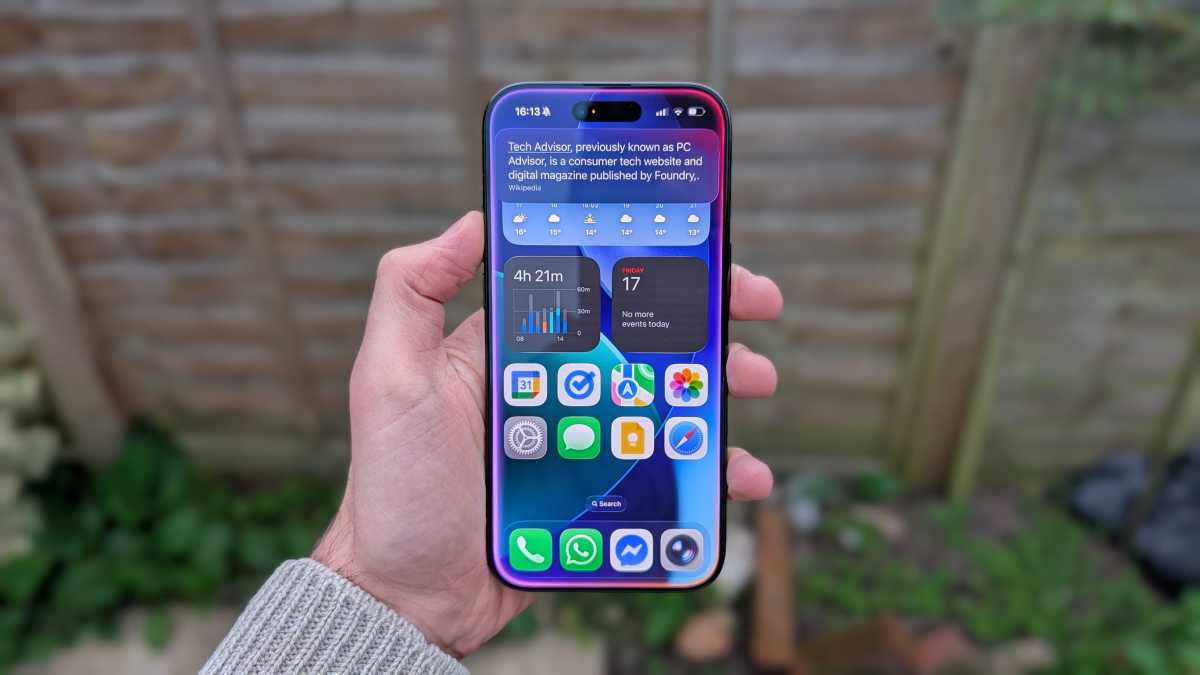
Anyron Copeman / Foundry
If you don’t really care about AI, iOS 26 is an accomplished and intuitive operating system that offers more ways to make it your own than ever before.
It’s also well served by software updates. Apple releases a major new version of iOS to all compatible devices at the same time, with support typically lasting for around five or six years. That’s slightly less than the best of Android, but you’ll probably be switching your phone sooner anyway.
Battery Life & Charging
- 3149mAh battery (unconfirmed)
- 20W wired charging
- 20W wireless MagSafe (Qi2) charging
Alongside the cameras, the iPhone Air’s battery represented my biggest concern.
Apple doesn’t reveal specific battery capacities, simply offering claims of up to 27 hours of video playback. That’s not a big downgrade compared to the 30 hours it suggests you can get from the regular iPhone 17, though my experience with the Galaxy S25 Edge had made me wary.
However, it’s been a pleasant surprise. Battery life isn’t a key strength of the iPhone Air, but it isn’t a weakness either. With moderate use – around three hours of screen-on time – a single charge will comfortably get you to the end of the day. If you work from home, as I do, you’re looking at closer to two days.
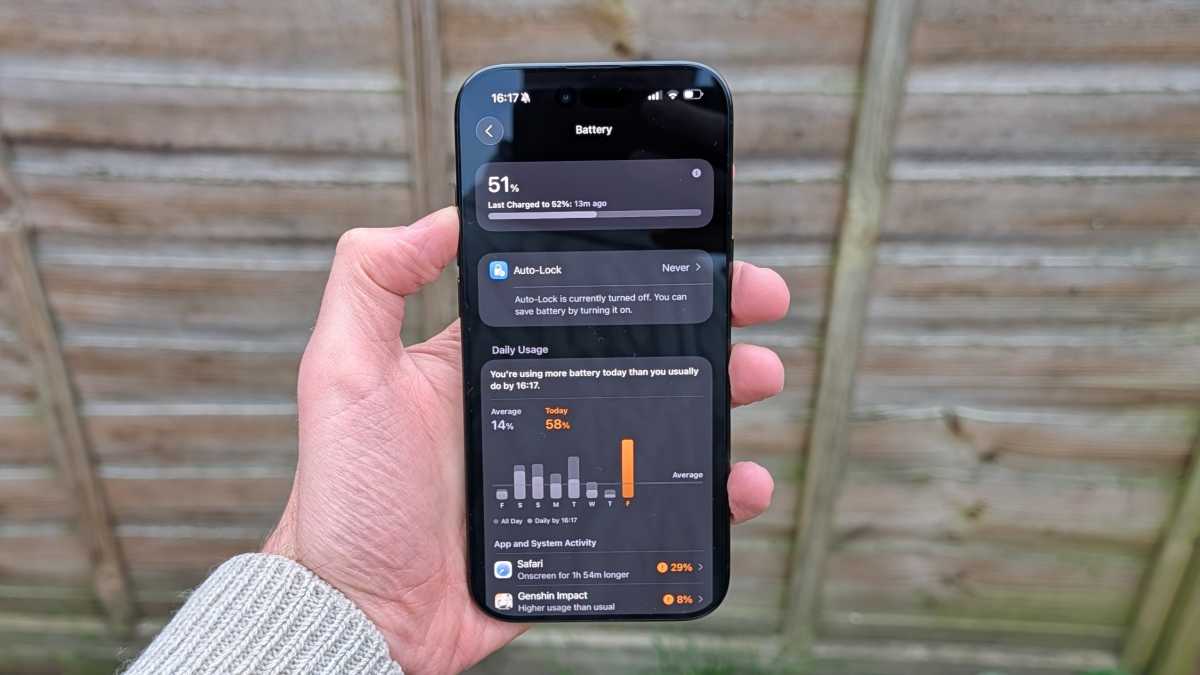
Anyron Copeman / Foundry
The usual PCMark battery test that we run on Android phones isn’t available on the iPhone, meaning that I can’t offer direct comparisons. But unless you plan on playing demanding games or constantly using location services, mobile data and high brightness, you don’t have to worry about battery life on the iPhone Air. I never imagined I’d be saying that, so Apple deserves credit here.
An area I won’t be giving it praise is charging speeds. The iPhone Air can only hit paltry 20W wired speeds, and you’ll need a compatible charger to take advantage of even that – a higher wattage doesn’t guarantee it.
Battery life isn’t a key strength of the iPhone Air, but it isn’t a weakness either
Apple says you can get up to 50% charge in 30 minutes, which is almost identical to my testing. Using a 67W charger, the phone went from empty to 27% in 15 minutes, hitting 51% by the half-hour mark.
You might as well use Qi2 MagSafe charging instead, as it can reach the same 20W speeds. Alongside traditional charging infrastructure, there’s a wide range of different first- and third-party accessories that take advantage of the built-in magnets on the back of the phone. They’re well worth exploring.
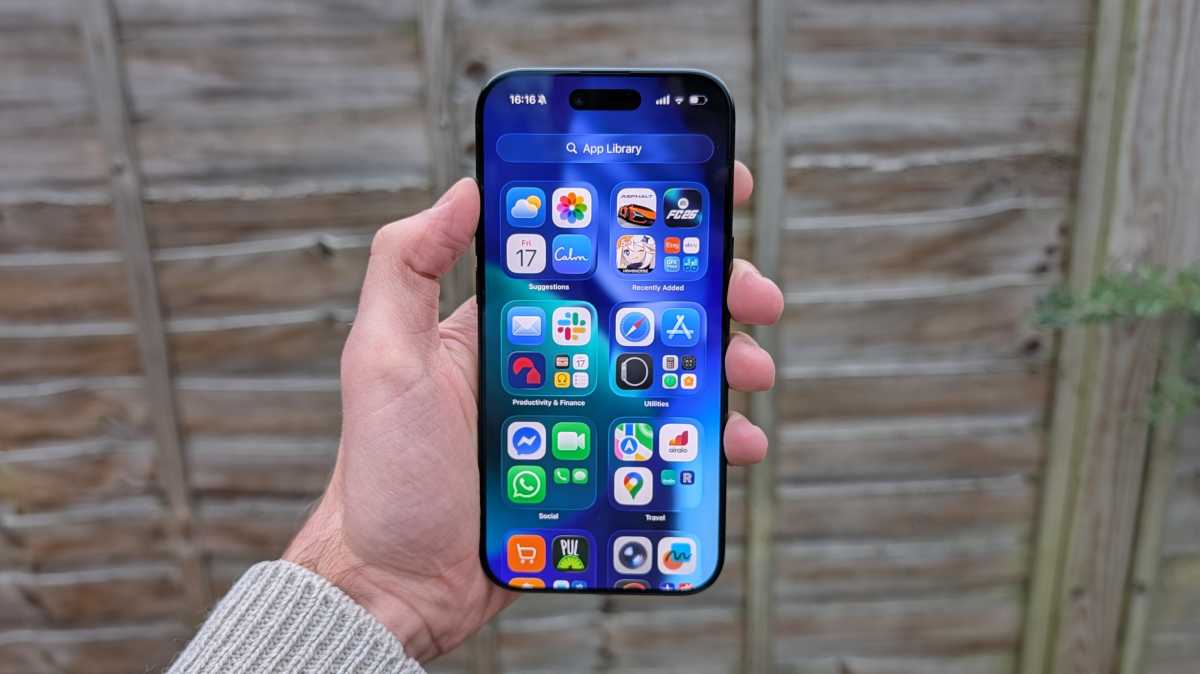
Anyron Copeman / Foundry
Price & Availability
At launch, the iPhone Air starts at £999/$999. That gets you 256GB of storage, but you can step up to 512GB or 1TB models for £1,199/$1,199 and £1,399/$1,399 respectively.
In the UK, it’s available directly from Apple or via retailers including Amazon. In the US, you can head to Apple or Best Buy, while plenty of networks are selling the phone on contract in both countries.
The outright price makes it £100/$100 cheaper than its ultra-slim rival in the Galaxy S25 Edge. If you don’t mind a thicker phone, the Pixel 10 Pro is also £999/$999, while the regular iPhone 17 is a tempting alternative that costs £200/$200 less.
See more great options in our guide to the best phones you can buy.
Should you buy the iPhone Air?
Probably not. I really enjoyed using it, but the iPhone Air isn’t a practical phone for most people to buy and use as their primary handset.
As gorgeous as the iPhone Air’s ultra-slim design is, too much has been sacrificed to achieve it.
The camera system is limited, the speakers are underwhelming, and battery life is worse than any of the iPhone 17 models, despite being better than expected.
When you can pay £200/$200 less and get significant improvements in all three of those areas, the iPhone Air becomes hard to justify. It offers a gorgeous display and brilliant performance, but that’s just not enough to make it a useful daily driver for most people.
Specs
- Colours: Space Black, Cloud White, Light Gold, Sky Blue
- Operating system: iOS 26
- Display: 6.5-inch Super Retina XDR 1-120Hz OLED
- Chipset: A19 Pro
- Storage: 256GB/512GB/1TB
- Rear camera: 48Mp f/1.6 main camera
- Front camera: 18Mp f/1.9 Centre Stage camera
- Charging: USB-C fast PD 2.0 20Wcharging, 20W wireless MagSafe charging, 20W wireless Qi 2 charging, 4.5W reverse wired
- Connectivity: Wi-Fi 7, Bluetooth 6, 5G NFC, eSIM-only
- Water and dust resistance: IP68
- Dimensions: 156.2 x 74.7 x 5.6 mm
- Weight: 165g
